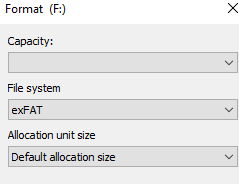Format ExFAT drive in Windows
ExFAT is faster than NTFS by up to several percent
hard drive write speed.
ExFAT allows a hard drive to easily be
read across operating systems.
Windows Subsystem for Linux can
read ExFAT
drives.
Formatting a disk deletes all data on the drive.
The system hard drive %SYSTEMDRIVE% for Windows OS MUST be NTFS.
NOTE: If the hard drive is unformatted, it will not have a drive letter. Once sure the drive is empty or want to erase the contents to make it ExFAT, do this through Disk Management.
Format a drive to ExFAT from Windows Explorer by right-clicking on the drive to format and selecting “Format” → File System: “ExFAT”

Format ExFAT
Alternatively, format a drive to ExFAT from Command Prompt or PowerShell by:
format driveletter /FS:exFAT /QFormat a drive to ExFAT from Disk Management by running diskmgmt.msc and right click the new drive → Format.
If NTFS is the only option, use Windows Explorer to format to ExFAT after first formatting to NTFS here.